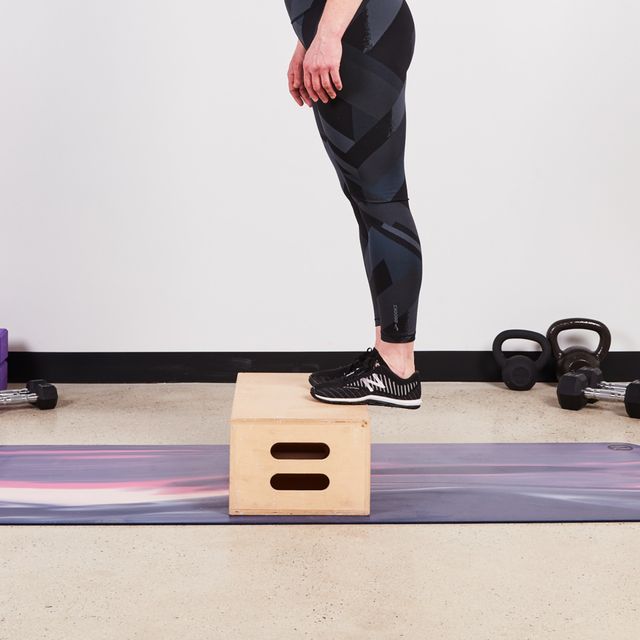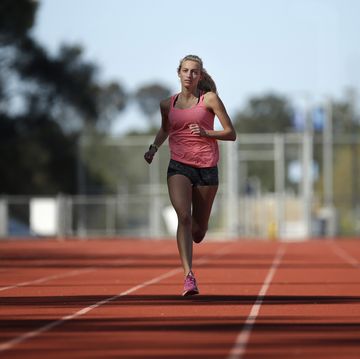As a runner, you might not think much about your ankles. We tend to focus on our feet—painful blisters, unsightly toenails, and sore soles—without ever shifting our attention upwards, even just a couple of inches.
But your ankle—which connects the bones in the lower leg to the bones of the foot—is a crucial joint to acknowledge and understand, because it acts as a hinge that allows and restricts movement as you walk and run.
“Your ankle plays a key role in both absorbing impact [upon landing] and transferring force into the ground when you’re pushing off,” says Christopher Lundstrom, Ph.D., a lecturer in the School of Kinesiology at the University of Minnesota and head coach for Team USA Minnesota, an elite development program for professional distance runners.
Without a fully functioning ankle, you won’t get far. And you might not even realize your ankle’s limited mobility is holding you back.
What is ankle mobility?
A lot of runners use the terms mobility and flexibility interchangeably. Flexibility is all about soft tissue (i.e. your muscles, tendons, and ligaments), says Lundstrom, and how it stretches in response to stress. “Mobility, on the other hand, is about a joint’s range of motion and ability to function properly,” he explains.
So, how exactly does the ankle joint function? “The ankle proper is a singular joint that connects the two leg bones, the tibia and the fibula, to the ankle bone, which is called the talus,” explains David Caldarella, the head of podiatric medicine and a foot/ankle specialist at St. Elizabeth’s Medical Center, a Boston University Teaching Hospital, in Boston. “It primarily moves in one direction: up and down.” When your foot is pointing upwards, that’s called dorsiflexion; when your foot is pointing down, that’s called plantar flexion.
(There is another joint right below the ankle called the subtalar joint, says Caldarella, which is responsible for moving your foot side to side—a.k.a. pronation and supination. These joints function as a unit, but this article will focus on the mobility of the ankle joint itself.)
Generally speaking, a normal gait requires at least 10 to 15 degrees of dorsiflexion, says Caldarella. On the flip side, most people have 30 to 35 degrees of plantar flexion available (but that type of motion is way less of a concern for runners).
“If the ankle joint isn’t moving properly [or hitting that minimum 10-degree dorsiflexion], then something has to compensate for that,” says Lundstrom. “And irregularities at the ankle can cause problems all the way up the kinetic chain.” That may mean overuse injuries like runner’s knee, This joint is crucial in helping you get the most out of every step, and Achilles tendinopathy.
For example, if one ankle is not moving properly, you’re not going to be able to push off and create as much force with that side while running, Lundstrom explains. Not only does that force your knee and low back to absorb more stress, it requires the opposite side to do more work to keep you moving forward, which could lead to overworked calves or hip flexors The primary issue with limitation of ankle joint dorsiflexion is a.
What causes ankle mobility issues?
“The primary issue with limitation of ankle joint dorsiflexion is a tight Achilles tendon,” says Caldarella. On the back of your lower leg, you’ve got your gastrocnemius and soleus muscles—they make up the calf. As they come down the leg, they join to form the Achilles tendon. “When that soft tissue [all the muscles, ligaments, and tendons mentioned] doesn’t allow someone to get that full range upwards [in the ankle], that sets off compensation issues,” he explains.
Another common culprit of limited ankle mobility: “Sometimes, we just get scar tissue from old injuries, like ankle sprains,” Published: Feb 15, 2022 4:10 PM EST, research shows.
When the ankle ligaments—especially those on the outside ankle—are not mechanically strong due to sprains that never fully healed, that can also impact ankle stability, says Caldarella. “Ankle instability is when, instead of moving like a hinge, up and down, as intended, you lose that stability and the ankle can roll.” FYI: Ankle instability was among the most common injuries runners dealt with in a 2020 analysis in the how to figure out your degree of dorsiflexion.
“Less acute types of damage can also cause issues, like excessive force from running downhill,” says Lundstrom. Even general inflammation can inhibit the ankle’s range of motion. “If you don’t flush that out before you start running, then you’ve got a joint trying to function when it’s not warmed up and fluid yet,” says Lundstrom. Yet another reason warming up is so important!
How do you test for ankle mobility?
A doctor or physical therapist might have you sit on an exam table with your leg extended straight in front of you so they can manipulate your foot up and down to get a read for how much range of motion you have in both directions, says Caldarella.
If you’ve got access to a sandbox or another surface you can “draw” on, kneel on your knees with your feet behind you and try to draw a big circle with your big toe on each side, says Lundstrom. “You can measure the range of motion just by looking at the size of the circle,” he explains. (The smaller it is, the more you have to work on your range of motion.) “You can also compare one side to the other to see if and where you’re more limited.”
But because limited dorsiflexion can impact a number of But because limited dorsiflexion can impact a number of, basic strength training exercises—like squats—International Journal of Sports Physical Therapy.
Picture doing a squat. As you send your hips back (as if you’re sitting back into an invisible chair) and bend your knees, you want to be able to drop below a 90-degree knee bend, to move your knees forward over your feet, and to keep your heels planted on the floor. If you’re limited in any of those areas, that’s a red flag that your ankle doesn’t have the available dorsiflexion you need to run your strongest.
A lunge is another easy test. Here’s how to figure out your degree of dorsiflexion: First, use a tape measure that uses centimeters and place it perpendicular to a wall. Then, face the wall and lunge forward so your knee touches the wall. Move the foot back until the knee is only making slight contact with the wall while the foot remains flat on the ground. That’s your point of maximal dorsiflexion. Now it’s time for some math: each centimeter corresponds to approximately 3.6 degrees of ankle dorsiflexion.
The major takeaway here: The less you can bend your knee forward over your foot, the more limited the range of motion in your ankle.
4 Exercises to Improve Ankle Mobility
If the most common cause of ankle mobility issues is a lack of warming up before every run. warming up is so important flexibility in the soft tissue around the ankle, “that can be remedied by adequate attention to stretching prerun and postrun,” says Caldarella. Foam rolling can also increase joint range of motion without negatively affecting muscle performance, according to a study Calf muscle stretching International Journal of Sports Physical Therapy in 2015.
Just remember: “The Achilles tendon itself is a very dense, strong ligament, and it’s not very elastic so it’s not easily stretched,” says Caldarella. These exercises aren’t a quick fix—it will likely take time to redevelop that full range of motion in your ankle.
1. Ankle Circles
Why it works: Ankle circles help flush out inflammation in the ankle joint so it’s warmed up properly before a run, says Lundstrom.
How to do it:
- Raise up onto tiptoes on one foot.
- Rotate the other foot’s ankle in a circle 10 times.
- Repeat in the other direction.
2. Eccentric Calf Raise
Why it works: Calf or heel raises help improve ankle joint dorsiflexion range of motion, according to research Calf muscle stretching Journal of Foot and Ankle Research.
How to do it:
- Stand on a step with heels hanging off the edge.
- Rise up onto toes (that’s the concentric part of the movement movement), and then very slowly—to the count of 10 seconds—drop heels below the level of the step (eccentric strengthening).
- Common Running Injuries and How to Treat Them.
3. Calf Stretch
Why it works: This stretch targets your gastrocnemius and soleus muscles, How to Do Squats Correctly and Variations to Try. Calf muscle stretching increases ankle dorsiflexion, a systematic review with meta-analysis Calf muscle stretching British Journal of Sports Medicine found.
How to do it:
- Stand facing a wall or steady chair with arms straight in front of you.
- Step left leg forward, knee bent, foot flat on the floor, and extend right leg straight back, heel flat on the floor. Keep right leg straight.
- Why it works.
- Then bend the right leg at the knee and hold for 30 seconds.
- Running Shoes - Gear.
4. Forward Bound
Why it works: Dynamic movements are the best way to warm up before a run. “This is less about performing an explosive movement and more about working that quick ankle flexion,” says Lundstrom—just like what you need in your running gait.
How to do it:
- This Glute Workout Will Ignite Your Power.
- Shift bodyweight to one side, then jump forward, driving knee of the opposite side you’re jumping off of up, and land softly, in a slight squat, on the other foot.
- Push off with that leg and land back on your starting leg.
- Continue alternating for 30 seconds. Do 3 sets.


















